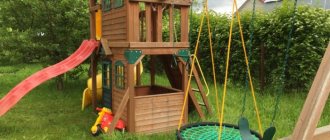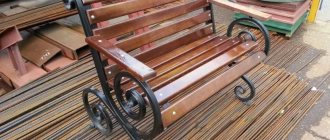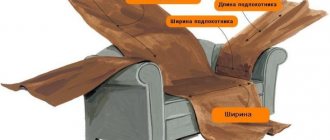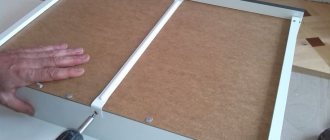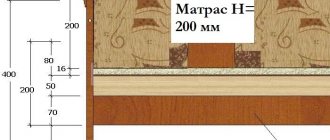Over time, furniture that is subject to intensive use - stools, chairs - loses its attractive appearance. But this does not mean that it has served its term and its place is in the landfill. Many items are made of high-quality, durable material and require only cosmetic updating. Restoring chairs with your own hands is a fascinating, creative event that allows you to refresh the appearance of your favorite furnishings or change it beyond recognition, giving it a second life in a new interior. Today’s material is about the sequence of work and popular techniques for restoring chairs.
DIY chair restoration
Benefits of DIY restoration
A chair that is updated at home can be designed better than it looked before. Restoration requires a minimum of materials and tools. Replacing holey or worn upholstery is a matter of one hour.
If the chair is antique, then it must be restored very carefully.
You can independently clean the wooden surface of old furniture and cover it with a transparent or tinted composition, or introduce new elements into the decor. For example, a chair is made with carved legs or a back, and the seat is reinforced so that it can be used for its intended purpose for a long time.
For restoration, many materials are available in the house - a piece of thick fabric, foam rubber, etc.
The costs of restoration at home are minimal. Before buying a new chair, think about whether it is possible to restore the old one and save a lot of money. Restoring antique furniture is especially expensive because it requires great care and exclusive materials. Updating furniture on your own will cost much less.
The updated chair, covered with a beautiful varnish, looks no less neat than when purchased.
Main types of fabrics
Before you begin, you need to decide on the type and color of the fabric that will be installed on the seats, as well as on the back of the chair. Many experts advise using only the most reliable fabric in such work.
To restore and decorate old and damaged chairs, it is preferable to use durable tapestry-based fabric containing 100% cotton and artificial fibers.
This material is considered quite strong and durable, it has increased wear resistance. The main advantage of a tapestry is its fibers, which are directed on one side.
But for the restoration of antique or rare furniture, it is advisable to use special silk for furniture. The base of this fabric has artificial fibers. And in appearance it looks very attractive and original. Chairs upholstered in silk will not leave anyone indifferent as they will have a chic and rich look.
When restoring antique antique chairs, it is necessary to use jacquard fabric. This is one of the most expensive and unusually beautiful materials for upholstering chairs. However, some antique chairs are also decorated with modern materials, such as arpatek and microfiber. The main advantage of these types of fabrics is their impeccable classic elegance.
Restoration process: step-by-step instructions
If the “original” bolts connecting the supporting structure become loose, they are strengthened with an additional washer. For greater reliability, you can add a little universal glue to the grooves.
Replace the sea grass and horsehair used in the old days as fillers with foam rubber.
A leaky seat is updated by replacing the base with slats and/or the upholstery is completely restored. The worn surface is freed from old material. The chair is prepared for further restoration:
- cut a piece of plywood to fit the seat;
- glue foam rubber onto the base (width - 3-4 cm);
- fix the plywood around the perimeter;
- stretch the upholstery fabric onto the finished base;
- secure the material with a stapler and staples.
A chair that is updated at home can be designed better than it looked before.
You can completely replace the back with a curly one, if the design allows.
You don't have to place the fabric on the outer sides of the seat. Then the upholstery is folded inward around the perimeter. The seat frame will be visible.
The fabric chosen is resistant to abrasion and mechanical stress, and quite dense.
A restored chair can be further decorated - make the wooden surface lighter or darker, or design the back or legs differently.
Replacing holey or worn upholstery is a matter of one hour.
When updating, you can use a variety of materials. With good carpentry skills, a restored chair acquires an individual style. This takes into account the material - wood type, density, texture.
| Scratch (crack) size | Means |
| Small shallow scratches | Iodine solution |
| Small cracks | Putty (carpentry, automotive) |
| Deep scratches | Shoe polish, mastic (heated beeswax + turpentine in a ratio of 4:3) |
You can independently clean the wooden surface of old furniture and cover it with a transparent or tinted composition, or introduce new elements into the decor.
The chairs included in the set must be decorated in the same style.
If the chair is antique, then it must be restored very carefully. Be sure to give the applied composition time to dry.
For an antique chair, choose decorative material with embroidery.
For your information . Antique chairs often have springs in the seat area, so you will need to find the same or similar ones, and remove old ones that have rusted and lost their elasticity. Replace the sea grass and horsehair used in the old days as fillers with foam rubber.
The costs of restoration at home are minimal.
Round the edges using a jigsaw and sand the edges with sandpaper.
Back restoration
To make the seat back very soft and comfortable, you need to use a compacted type of cardboard or thin plywood sheet that has exact and similar dimensions.
At the same time, plywood and foam rubber must also have the exact dimensions of the back of the chair. But the batting and upholstery during installation should have a small release tolerance of about five centimeters, but no more.
Also, to decorate the back of the chair, you need to install a pre-selected fabric for upholstery. It is stretched face down, and a piece of plywood is installed on its upper part.
Next, on this surface you need to install a sheet of batting and foam rubber prepared to size, after which the upholstery fabric is stretched over them. All this is securely fixed using special brackets.
The entire finished surface should not have any roughness, flaws or bumps, it should be perfectly smooth and even, and all excess should be cut off with a knife. After this, process around the entire perimeter of the seat and back, using braid or cord to hide all visible seams.
BRA lamps- Window sills made of artificial stone in the interior
- 3D interior visualization - why is it needed?
Required materials and tools
To restore the chairs you will need the following:
- quick-drying varnish (clear or tinted);
- dye;
- upholstery fabric;
- foam;
- plywood;
- sandpaper;
- metal washers and bolts (screws);
- springs (for a specific type of chair).
Sandpaper will be needed to clean the surface of the furniture from uneven surfaces, chips and cracks in the varnish.
The fabric chosen is resistant to abrasion and mechanical stress, and quite dense. Tapestry, flock, matting, etc. are suitable. For an antique chair, choose decorative material with embroidery.
Updating furniture on your own will cost much less.
Select the wooden base according to its density and texture in advance, cut it to size and use a pattern to create the desired design.
Sandpaper will be needed to clean the surface of the furniture from uneven surfaces, chips and cracks in the varnish. It is necessary to completely sand the chair (wooden structure) for a smooth application of the laminating compound.
For major repairs, the chair can be disassembled, the broken parts replaced with new ones and fastened with bolts or screws.
To update the chair, you need the following tools:
- scissors;
- roulette;
- wood saw (saw off excess plywood under the seat);
- screwdriver;
- screwdriver.
For greater reliability, you can add a little universal glue to the grooves.
For major repairs, the chair can be disassembled, the broken parts replaced with new ones and fastened with bolts or screws. Seat frames also often require restoration.
Seat frames also often require restoration.
A Viennese chair or any other looks best in this design.
Important ! It is necessary to use wood species that are similar in density and texture so that the chair is functional and looks presentable.
A leaky seat is updated by replacing the base with slats and/or the upholstery is completely restored.
What glue should I use for repair work?
If a wooden chair is broken, then it is recommended to use the best wood glue for repair. Nowadays the greatest demand is:
- "Kleyberite."
- "Moment" carpentry.
- "Trebond."
Professional carpenters put forward the following requirements for glue:
- It must be resistant to sunlight.
- Universal to use.
- The adhesive connection must be strong.
- It is recommended to use moisture-resistant glue.
- There should be no sticky residue left on the surface.
- Should not be toxic.
If you ask a professional craftsman how to glue a wooden chair, he will probably recommend using epoxy glue. It is best suited for wood products. PVA glue can be used. Some people use a two-component composition.
Methods of restoration by decorating a chair
There are several options for designing the appearance of furniture. The chair can be updated in the following ways:
- coloring;
- lamination;
- decoupage
It is necessary to use wood species that are similar in density and texture so that the chair is functional and looks presentable.
As decoration, you can use both the upholstery itself, choosing a fabric of interesting colors like a tapestry, and other parts of the furniture, making them carved and figured.
You don't have to place the fabric on the outer sides of the seat.
A plain seat is decorated with smooth embroidery or appliqué. This must be done before starting the sheathing.
A plain seat is decorated with smooth embroidery or appliqué.
The wooden surface of the supporting structure and the back are laminated, that is, covered with durable varnish in several layers. The tone of the coating is selected closer to the natural shade of the wood (light, dark or moderate). A Viennese chair or any other looks best in this design.
A restored chair can be further decorated - make the wooden surface lighter or darker, or design the back or legs differently.
You can completely replace the back with a curly one, if the design allows. Select the wooden base according to its density and texture in advance, cut it to size and use a pattern to create the desired design. Round the edges using a jigsaw and sand the edges with sandpaper.
The wooden surface of the supporting structure and the back are laminated, that is, covered with durable varnish in several layers.
The chairs included in the set must be decorated in the same style so that they do not stand out from the overall picture - “different-sized” furniture may look good in different rooms, but at a common table, for example, when celebrating a family celebration, it looks careless.
When updating, you can use a variety of materials.
How to update an old chair? Pre-cleaning
First, the surface of the chair must be cleaned of the old coating, no matter what it is. If there is soft seat upholstery, it must first be removed. You don’t necessarily need “male strength” to do this. Try turning the chair upside down and you will see that the seat is attached with screws that need to be removed. To do this, you need to arm yourself with a hammer (for knocking out the seat) and a screwdriver (straight or Phillips).
Now you can start removing the old coating.
To do this, you can use regular sandpaper of different grain sizes or a sanding sponge. It is important to sand the surface of the wood well. This will help you easily apply the coating you choose later. It is worth saying right away that this work is not easy. But it is possible to simplify the process a little by periodically moistening the surface to be treated. This way you can get rid of dust. Just don’t be alarmed by the fact that moisture makes the old varnish viscous. This is fine. After the chair has completely dried, you need to sand the entire surface well again with fine sandpaper.
Photo ideas for beautiful decor of chairs
Read: Ceramic tiles for the bathroom: tips for choosing and the best ideas for using modern tiles
Let's discuss this article together:
Click to cancel reply.

